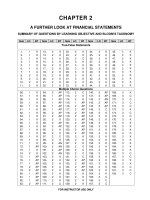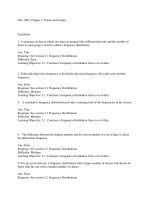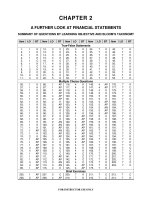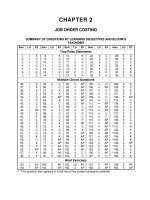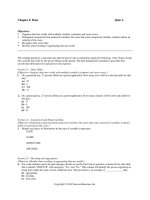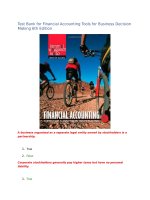Statistics for business decision making and analysis robert stine and foster chapter 11
Bạn đang xem bản rút gọn của tài liệu. Xem và tải ngay bản đầy đủ của tài liệu tại đây (242.61 KB, 30 trang )
Chapter 11
Probability Models for
Counts
Copyright © 2011 Pearson Education, Inc.
11.1 Random Variables for Counts
How many doctors should management
expect a pharmaceutical rep to meet in a
day if only 40% of visits reach a doctor? Is
a rep who meets 8 or more doctors in a day
doing exceptionally well?
Need a discrete random variable to model
counts and provide a method for finding
probabilities
3 of 30
Copyright © 2011 Pearson Education, Inc.
11.1 Random Variables for Counts
Bernoulli Random Variable
Bernoulli trials are random events with three
characteristics:
Two possible outcomes (success, failure)
Fixed probability of success (p)
Independence
4 of 30
Copyright © 2011 Pearson Education, Inc.
11.1 Random Variables for Counts
Bernoulli Random Variable - Definition
A random variable B with two possible
values, 1 = success and 0 = failure, as
determined in a Bernoulli trial.
E(B) = p
Var(B) = p(1-p)
5 of 30
Copyright © 2011 Pearson Education, Inc.
11.1 Random Variables for Counts
Counting Successes (Binomial)
Y, the sum of iid Bernoulli random
variables, is a binomial random variable
Y = number of success in n Bernoulli trials
(each trial with probability of success = p)
Defined by two parameters: n and p
6 of 30
Copyright © 2011 Pearson Education, Inc.
11.1 Random Variables for Counts
Counting Successes (Binomial)
We can define the number of doctors seen
by a pharmaceutical rep in 10 visits as a
binomial random variable
This random variable, Y, is defined by
n = 10 visits and p = 0.40 (40% success in
reaching a doctor)
7 of 30
Copyright © 2011 Pearson Education, Inc.
11.2 Binomial Model
Assumptions
Using a binomial random variable to
describe a real phenomenon
10% Condition: if trials are selected at
random, it is OK to ignore dependence
caused by sampling from a finite population
if the selected trials make up less than
10% of the population
8 of 30
Copyright © 2011 Pearson Education, Inc.
11.3 Properties of Binomial Random
Variables
Mean and Variance
E(Y) = np
Var(Y) = np(1 - p)
9 of 30
Copyright © 2011 Pearson Education, Inc.
11.3 Properties of Binomial Random
Variables
Pharmaceutical Rep Example
E(Y) = np = (10)(0.40) = 4
We expect a rep to see 4 doctors in 10 visits.
Var(Y) = np(1 - p) = (1)(0.40)(0.60) = 2.4
SD(Y) = 1.55
A rep who has seen 8 doctors has performed
2.6 standard deviations above the mean.
10 of 30
Copyright © 2011 Pearson Education, Inc.
11.3 Properties of Binomial Random
Variables
Binomial Probabilities
Consist of two parts:
The probability of a specific sequence of
Bernoulli trials with y success in n attempts
The number of sequences that have y
successes in n attempts (binomial
coefficient)
11 of 30
Copyright © 2011 Pearson Education, Inc.
11.3 Properties of Binomial Random
Variables
Binomial Probabilities
Binomial probability for y success in n trials
P ( Y = y ) = n C y p (1 − p )
y
n− y
12 of 30
Copyright © 2011 Pearson Education, Inc.
11.3 Properties of Binomial Random
Variables
Pharmaceutical Rep Example
P(Y = 8) = 10C8(0.4)8(0.6)2 = 0.011
The probability of seeing 8 doctors in 10
visits is only about 1%.
13 of 30
Copyright © 2011 Pearson Education, Inc.
11.3 Properties of Binomial Random
Variables
Probability Distribution for Rep Example
14 of 30
Copyright © 2011 Pearson Education, Inc.
11.3 Properties of Binomial Random
Variables
Pharmaceutical Rep Example
P(Y ≥ 8)= P(Y = 8) + P(Y = 9) + P(Y = 10)
= 0.01062 + 0.00157 + 0.00010
= 0.01229
The probability of seeing 8 or more doctors in
10 visits is only slightly above 1%. This
rep is doing exceptionally well!
15 of 30
Copyright © 2011 Pearson Education, Inc.
4M Example 11.1: FOCUS ON SALES
Motivation
A focus group with nine randomly chosen
participants was shown a prototype of a new
product and asked if they would buy it at a
price of $99.95. Six of them said yes. The
development team claimed that 80% of
customers would buy the new product at that
price. If the claim is correct, what results
would we expect from the focus group?
16 of 30
Copyright © 2011 Pearson Education, Inc.
4M Example 11.1: FOCUS ON SALES
Method
Use the binomial model for this situation.
Each focus group member has two
possible responses: yes, no. We can use
X ~ Bi(n = 9, p = 0.8) to represent the
number of yes responses out of nine.
17 of 30
Copyright © 2011 Pearson Education, Inc.
4M Example 11.1: FOCUS ON SALES
Mechanics – Find E(X) and SD(X)
E(X) = np = (9)(0.8) = 7.2
Var(X) = np(1-p) = (9)(0.8)(0.2) = 1.44
SD(X) = 1.2
The expected number is higher than the
observed number of 6.
18 of 30
Copyright © 2011 Pearson Education, Inc.
4M Example 11.1: FOCUS ON SALES
Mechanics – Probability Distribution
While 6 is not the most likely outcome,
it is still common.
19 of 30
Copyright © 2011 Pearson Education, Inc.
4M Example 11.1: FOCUS ON SALES
Message
The results of the focus group are in line
with what we would expect to see if the
development team’s claim is correct.
20 of 30
Copyright © 2011 Pearson Education, Inc.
11.4 Poisson Model
A Poisson Random Variable
Describes the number of events
determined by a random process during an
interval of time or space
Is not finite (possible values are infinite)
Is defined by λ (lambda), the rate of events
21 of 30
Copyright © 2011 Pearson Education, Inc.
11.4 Poisson Model
The Poisson Probability Distribution
P( X = x ) = e
−λ
λ
x!
x
x = 0, 1, 2, ...
E(X) = λ
Var(X) = λ
22 of 30
Copyright © 2011 Pearson Education, Inc.
11.4 Poisson Model
The Poisson Model
Uses a Poisson random variable to
describe counts of data
Is appropriate for situations like
• The number of calls arriving at the help desk in
a 10-minute interval
• The number of imperfections per square meter
of glass panel
23 of 30
Copyright © 2011 Pearson Education, Inc.
4M Example 11.2: DEFECTS IN
SEMICONDUCTORS
Motivation
A supplier claims that its wafers have 1
defect per 400 cm2. Each wafer is 20 cm in
diameter, so the area is 314 cm2. What is
the mean number of defects and the
standard deviation?
24 of 30
Copyright © 2011 Pearson Education, Inc.
4M Example 11.2: DEFECTS IN
SEMICONDUCTORS
Method
The random variable is the number of
defects on a randomly selected wafer.
The Poisson model applies.
25 of 30
Copyright © 2011 Pearson Education, Inc.

